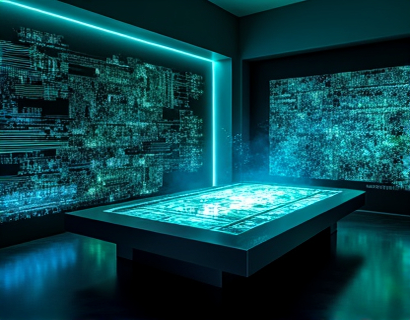Exploring Ancient Egypt Through AI-Driven Insights and Authentic Artifacts
The allure of ancient Egypt has captivated human imagination for centuries, drawing scholars, adventurers, and enthusiasts from around the globe. This timeless fascination stems from the profound legacy of a civilization that left behind an unparalleled wealth of cultural, architectural, and artistic treasures. In recent years, the integration of artificial intelligence (AI) has revolutionized the way we explore and understand Egypt's ancient secrets. This article delves into how AI-driven resources can provide deep insights into Egyptian history and culture, while also offering a unique opportunity to connect with this heritage through authentic artifacts.
AI as a Tool for Uncovering Ancient Secrets
AI technology, with its advanced data processing and pattern recognition capabilities, has become an indispensable tool in the field of archaeology and Egyptology. By analyzing vast amounts of historical data, AI can identify patterns and connections that might elude human researchers. For instance, machine learning algorithms can process satellite imagery to detect hidden structures beneath the desert sands, revealing potential archaeological sites. This technology has already led to the discovery of several previously unknown tombs and temples, expanding our understanding of ancient Egyptian urban planning and religious practices.
Moreover, AI-driven tools can analyze hieroglyphs and other ancient texts with remarkable accuracy. Natural language processing (NLP) algorithms can decipher and translate ancient texts, providing insights into the daily life, beliefs, and governance of the ancient Egyptians. These translations are not only more accurate but also faster than traditional methods, allowing researchers to access a wealth of information that was previously inaccessible.
Enhancing Educational Resources with AI
The educational value of AI in studying ancient Egypt is immense. Online platforms and educational resources can leverage AI to create interactive and immersive learning experiences. Virtual reality (VR) and augmented reality (AR) applications, powered by AI, can transport students and enthusiasts to ancient Egypt, allowing them to explore temples, pyramids, and marketplaces as if they were there. These experiences are enriched by AI-generated narratives and historical context, making learning both engaging and informative.
Additionally, AI can personalize learning by adapting content to the user's level of knowledge and interests. For beginners, AI can provide foundational information and guide them through the basics of Egyptian history and culture. For more advanced learners, AI can delve into specialized topics such as the intricacies of hieroglyphic writing or the engineering marvels of the pyramids. This personalized approach ensures that every user, regardless of their background, can gain a deeper understanding of ancient Egypt.
Discovering Authentic Egyptian Artifacts
While AI provides invaluable insights into ancient Egypt's history and culture, there is nothing quite like experiencing the tangible connection to this heritage through authentic artifacts. These objects, crafted by skilled hands thousands of years ago, offer a direct link to the past, allowing us to touch and feel the legacy of a bygone era. For those interested in owning a piece of this timeless legacy, a curated collection of authentic Egyptian artifacts is available.
These artifacts range from intricate jewelry and pottery to finely carved stone statues and papyrus scrolls. Each piece is carefully selected to ensure its authenticity and historical significance. The process of verifying the authenticity of these artifacts involves rigorous examination by experts in Egyptology and archaeology. This ensures that every item offered is not only genuine but also ethically sourced, respecting the cultural heritage it represents.
Jewelry and Adornments
Egyptian jewelry is renowned for its beauty and symbolic significance. Pieces from this collection include golden collars adorned with lapis lazuli and carnelian, reflecting the wealth and status of their ancient wearers. Intricate beadwork and gemstone inlays showcase the exceptional craftsmanship of ancient Egyptian artisans. These jewelry pieces are not only stunning but also carry the spiritual and cultural meanings that were important to the people of ancient Egypt.
Pottery and Ceramics
The pottery and ceramics from ancient Egypt provide a glimpse into the daily lives of its people. The collection features vessels of various shapes and sizes, from practical cooking pots to elaborate storage jars. These items are often decorated with scenes from mythology, daily life, and religious rituals, offering insights into the beliefs and practices of the time. The textures and colors of these ceramics are as vibrant today as they were when they were first created, making them a tangible connection to the past.
Sculptures and Statues
Sculptures and statues from ancient Egypt are some of the most iconic artifacts, representing gods, pharaohs, and everyday people. The collection includes finely detailed stone statues, such as those of Anubis and Isis, as well as smaller figurines made from clay or wood. These sculptures not only serve as artistic masterpieces but also as religious and funerary objects, reflecting the deep spiritual beliefs of the ancient Egyptians. Each statue is accompanied by detailed descriptions and historical context, enhancing the viewer's understanding of its significance.
Papyrus and Texts
Papyrus scrolls and fragments are a crucial part of the collection, offering a direct link to the written records of ancient Egypt. These scrolls contain a variety of texts, including religious hymns, legal documents, and literary works. The preservation of these fragile documents is a testament to the advanced techniques used by ancient scribes. By studying these texts, we gain valuable insights into the language, religion, and society of ancient Egypt.
Additionally, the collection may include replicas of significant texts, such as the Book of the Dead, which guided the deceased through the afterlife. These replicas are meticulously crafted to capture the essence of the originals, allowing enthusiasts to explore the intricate hieroglyphs and symbols that held such importance in ancient Egyptian culture.
The Intersection of AI and Ancient Artifacts
The integration of AI in the study and preservation of ancient artifacts enhances the overall experience for enthusiasts and researchers. AI can help in the conservation and restoration of artifacts by analyzing their condition and suggesting the best methods for preservation. For example, machine learning algorithms can identify areas of wear and predict the effects of environmental factors, allowing conservators to take proactive measures.
Furthermore, AI can assist in the authentication and provenance research of artifacts. By analyzing stylistic features, materials, and manufacturing techniques, AI can help determine the authenticity and origin of an artifact. This is particularly important for items that have been in circulation or have uncertain histories, ensuring that only genuine pieces reach collectors and museums.
Supporting Cultural Heritage Through Ethical Collecting
While the allure of owning a piece of ancient Egypt's heritage is undeniable, it is crucial to approach collecting with ethical considerations in mind. The illegal trade of cultural artifacts is a significant concern, leading to the loss of historical context and the degradation of cultural heritage. By sourcing artifacts from reputable collectors and institutions that prioritize ethical practices, enthusiasts can support the preservation and appreciation of Egypt's cultural legacy.
The curated collection mentioned earlier is a testament to this commitment. Each artifact is obtained through legal and ethical means, with detailed documentation of its history and provenance. This transparency not only ensures the authenticity of the items but also supports the local communities and institutions that safeguard Egypt's cultural heritage.
Conclusion
AI-driven resources offer a powerful tool for exploring the rich history and culture of ancient Egypt. From uncovering new archaeological sites to deciphering ancient texts, AI enhances our understanding and appreciation of this fascinating civilization. Meanwhile, the opportunity to own authentic artifacts provides a tangible connection to this timeless legacy, allowing enthusiasts to bring a piece of ancient Egypt into their lives.
Whether you are a scholar, a student, or a passionate enthusiast, the combination of AI insights and authentic artifacts offers a comprehensive and enriching experience. By supporting ethical collecting and preservation efforts, we can ensure that the wonders of ancient Egypt continue to inspire and educate future generations.











































